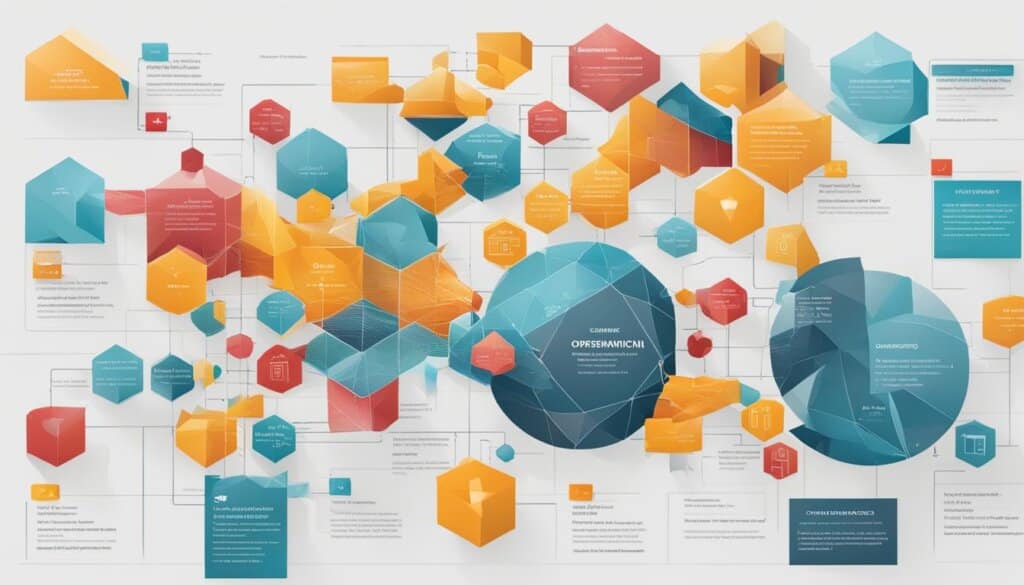Table of Contents
An operating model is a visual representation of how an organisation delivers value to its internal and external customers. It helps employees understand the role each part of the organisation plays in meeting the needs of other components. Operating models also help managers analyse how changes in one part of the organisation might affect the value delivered by other parts.
Operating models can be high level or granular, depending on the complexity of the organisation’s strategic plan. They can be documented through visualization by internal design teams or using flowcharts.
One popular framework for creating an operating model is the Operating Model Canvas (OMC), which captures six essential elements: processes, organization, locations, information, suppliers, and management systems (POLISM).
How Does an Operating Model Work?
An operating model provides a roadmap for executing an organization’s business model. It shows how each part of the organization works together to deliver value. Whether it’s a large organization or a smaller company, visualizing the operating model is crucial for effective implementation.
When creating an operating model, organizations can approach it from a top-down perspective, ensuring alignment with strategic objectives. The model can be developed at a high level or in a granular way, depending on the complexity of the organization’s structure and goals.
In large organizations, internal design teams with expertise in visualization typically document the operating models. This ensures a comprehensive and visually appealing representation of how the organization functions. Smaller companies may opt for flowcharts to illustrate their operating model.
The process of documenting an operating model can take anywhere from a few days to several months. The duration depends on factors such as the complexity of the organization’s strategic plan and the level of detail required.
An operating model is not set in stone. It can evolve ad hoc as the organization grows and adapts to new challenges and opportunities. However, implementing a well-designed operating model from the start provides a solid foundation for efficient operations and successful outcomes.
Frameworks like the Operating Model Canvas can facilitate the creation of an operating model. This framework outlines six key elements that need to be considered: processes, organization, locations, information, suppliers, and management systems. By utilizing such frameworks, organizations can effectively visualize and document their operating models.
“A well-executed operating model is essential for achieving organizational goals and delivering value to stakeholders. It serves as a compass, guiding the organization towards success by providing a clear roadmap for execution.”
Benefits of Visualizing the Operating Model
Visualizing the operating model offers several benefits:
- Enhanced understanding: A visual representation helps employees grasp how different parts of the organization work together to achieve common objectives.
- Improved communication: Visuals make it easier to convey complex concepts and processes to stakeholders.
- Efficient decision-making: With a clear overview of the operating model, managers can identify areas for improvement and make informed decisions.
- Alignment of resources: Visualization enables organizations to allocate resources effectively, ensuring they are utilized in accordance with the desired outcomes.
By leveraging visualization techniques, organizations can optimize their operating models and drive sustainable growth.
| Benefits of Visualizing the Operating Model | Description |
|---|---|
| Enhanced Understanding | A visual representation helps employees grasp how different parts of the organization work together to achieve common objectives. |
| Improved Communication | Visuals make it easier to convey complex concepts and processes to stakeholders. |
| Efficient Decision-making | With a clear overview of the operating model, managers can identify areas for improvement and make informed decisions. |
| Alignment of Resources | Visualization enables organizations to allocate resources effectively, ensuring they are utilized in accordance with the desired outcomes. |
What is Included in an Operating Model?
An operating model includes various visual tools that explain how a company’s capabilities and business processes align with its overall strategy and deliver value. These tools can include business capability models, which represent what a business can do in a logical framework, and capability maturity models, which are used to develop and refine software development processes. Other elements of an operating model can include management structures, resource portfolios, supplier matrices, people models, IT priorities, location maps, and decision grids. These tools help depict the steps necessary to complete the organization’s work and deliver the desired business outcomes.
| Visual Tools | Description |
|---|---|
| Business Capability Models | Logical frameworks representing what a business can do. |
| Capability Maturity Models | Used to develop and refine software development processes. |
| Management Structures | Organizational hierarchies and reporting relationships. |
| Resource Portfolios | Allocation and management of organizational resources. |
| Supplier Matrices | Assessment and relationship management of suppliers. |
| People Models | Representation of roles, responsibilities, and competencies. |
| IT Priorities | Alignment of technology initiatives with business strategies. |
| Location Maps | Physical or virtual representation of organizational locations. |
| Decision Grids | Structured frameworks for making key business decisions. |
| Value Delivery Chain | The sequence of activities that contribute to delivering value to customers. |
If you are interested in visualizing an operating model, here is an example:

Next, we will explore how to create an operating model and the importance of aligning it with your business strategy.
How to Create an Operating Model?
An operating model plays a crucial role in guiding an organization towards effective value delivery. To create a robust operating model, organizations can follow the POLISM framework, comprising of six key elements: processes, organization, locations, information, suppliers, and management systems.
Here is a step-by-step guide to creating an operating model:
- Define your business strategy: Start by clearly defining your organization’s overarching business strategy. This strategic direction will serve as a guiding framework for building your operating model.
- Identify value-delivering processes: Analyze your business processes and identify the ones that directly contribute to value creation. These processes should align closely with your business strategy and should be optimized for efficiency and effectiveness.
- Design the organizational structure: Establish a well-defined organizational structure that supports the execution of the identified processes. Clearly define roles, responsibilities, and reporting lines to ensure smooth coordination and communication within the organization.
- Determine success metrics: Define clear success metrics and key performance indicators (KPIs) that align with your business strategy. These metrics will help you evaluate the effectiveness of your operating model and track progress towards your strategic goals.
- Select and implement technology: Identify the technology and information systems required to support your operating model. Evaluate available options and implement the most suitable technology solutions to enable efficient information flow and collaboration within the organization.
- Align with suppliers and partners: Establish strong relationships with suppliers and partners to ensure seamless integration and coordination. Collaborate closely with them to optimize the flow of inputs and leverage their expertise to enhance value delivery.
By following these steps and leveraging frameworks like the Operating Model Canvas, organizations can effectively create an operating model that aligns with their business strategy and drives sustainable value delivery.
Example Operating Model Canvas:
| POLISM Element | Description |
|---|---|
| Processes | A clear identification and mapping of core value-delivering processes. |
| Organization | An optimized organizational structure that supports agile execution. |
| Locations | Effective distribution of resources across geographical locations. |
| Information | Enabled information flow and technology systems for seamless collaboration. |
| Suppliers | Strong partnerships for reliable and efficient supply chain management. |
| Management Systems | Robust systems for monitoring, evaluation, and continuous improvement. |
Creating an operating model that aligns with your organization’s strategy is a critical step towards ensuring efficient value delivery and sustainable growth.
Operating Model Examples
One notable example of an operating model is Patagonia, the renowned outdoor apparel brand. Patagonia’s operating model is built around a compelling value proposition that focuses on limiting its environmental footprint while providing high-quality outdoor wear. It is committed to aligning its activities with environmental goals and uses strategic supply-chain partnerships to create more sustainable ecosystems and business processes.
In today’s technologically advanced world, incorporating technology into an operating model is essential for delivering value to customers. Patagonia leverages technology and innovation, such as internet of things (IoT) technology, to enhance its operations and improve the customer experience. By utilizing IoT, Patagonia can gather and analyze data to make better business decisions and automate certain processes, resulting in more efficient value delivery to its customers.
The success of Patagonia’s operating model demonstrates how a company’s commitment to its value proposition and environmental goals can drive innovation and sustainable practices. By embracing technology and leveraging IoT capabilities, organizations can further enhance their operating models to deliver even greater value to their customers while aligning with their environmental objectives.
FAQ
What is an operating model?
An operating model is a visual representation of how an organization delivers value to its internal and external customers. It helps employees understand the role each part of the organization plays in meeting the needs of other components.
How does an operating model work?
An operating model provides a roadmap for executing an organization’s business model. It shows how each part of the organization works together to deliver value. The operating model can be organized from the top down and can be high level or granular. In large organizations, internal design teams with visualization expertise usually document the operating models, while smaller companies may use flowcharts.
What is included in an operating model?
An operating model includes various visual tools that explain how a company’s capabilities and business processes align with its overall strategy and deliver value. These tools can include business capability models, which represent what a business can do in a logical framework, and capability maturity models, which are used to develop and refine software development processes. Other elements of an operating model can include management structures, resource portfolios, supplier matrices, people models, IT priorities, location maps, and decision grids.
How to create an operating model?
An operating model can be created using the POLISM framework, which includes six elements: processes, organization, locations, information, suppliers, and management systems. To create an operating model, organizations need to define their business strategy, identify the processes and tools that deliver value, define the organizational structure and the roles and responsibilities within it, determine success metrics and the technology needed to achieve them, and align all these elements with the business strategy.
What are some operating model examples?
Examples of operating models include Patagonia, the outdoor apparel brand, which has a value proposition built around limiting its environmental footprint while providing high-quality outdoor wear. Patagonia aligns its activities with environmental objectives and uses supply-chain partners to create more sustainable ecosystems and business processes. Technology also plays a role in developing an operating model that delivers value to customers. For example, the use of internet of things (IoT) technology can help organizations better deliver value to customers by incorporating data and automation into their operations.







